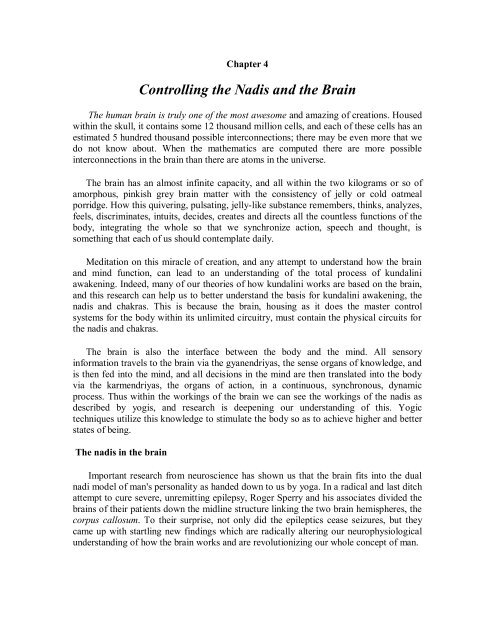Kundalini.Tantra.by.Satyananda.Saraswati
You also want an ePaper? Increase the reach of your titles
YUMPU automatically turns print PDFs into web optimized ePapers that Google loves.
Chapter 4<br />
Controlling the Nadis and the Brain<br />
The human brain is truly one of the most awesome and amazing of creations. Housed<br />
within the skull, it contains some 12 thousand million cells, and each of these cells has an<br />
estimated 5 hundred thousand possible interconnections; there may be even more that we<br />
do not know about. When the mathematics are computed there are more possible<br />
interconnections in the brain than there are atoms in the universe.<br />
The brain has an almost infinite capacity, and all within the two kilograms or so of<br />
amorphous, pinkish grey brain matter with the consistency of jelly or cold oatmeal<br />
porridge. How this quivering, pulsating, jelly-like substance remembers, thinks, analyzes,<br />
feels, discriminates, intuits, decides, creates and directs all the countless functions of the<br />
body, integrating the whole so that we synchronize action, speech and thought, is<br />
something that each of us should contemplate daily.<br />
Meditation on this miracle of creation, and any attempt to understand how the brain<br />
and mind function, can lead to an understanding of the total process of kundalini<br />
awakening. Indeed, many of our theories of how kundalini works are based on the brain,<br />
and this research can help us to better understand the basis for kundalini awakening, the<br />
nadis and chakras. This is because the brain, housing as it does the master control<br />
systems for the body within its unlimited circuitry, must contain the physical circuits for<br />
the nadis and chakras.<br />
The brain is also the interface between the body and the mind. All sensory<br />
information travels to the brain via the gyanendriyas, the sense organs of knowledge, and<br />
is then fed into the mind, and all decisions in the mind are then translated into the body<br />
via the karmendriyas, the organs of action, in a continuous, synchronous, dynamic<br />
process. Thus within the workings of the brain we can see the workings of the nadis as<br />
described <strong>by</strong> yogis, and research is deepening our understanding of this. Yogic<br />
techniques utilize this knowledge to stimulate the body so as to achieve higher and better<br />
states of being.<br />
The nadis in the brain<br />
Important research from neuroscience has shown us that the brain fits into the dual<br />
nadi model of man's personality as handed down to us <strong>by</strong> yoga. In a radical and last ditch<br />
attempt to cure severe, unremitting epilepsy, Roger Sperry and his associates divided the<br />
brains of their patients down the midline structure linking the two brain hemispheres, the<br />
corpus callosum. To their surprise, not only did the epileptics cease seizures, but they<br />
came up with startling new findings which are radically altering our neurophysiological<br />
understanding of how the brain works and are revolutionizing our whole concept of man.














![[Lonely Planet] Sri Lanka](https://img.yumpu.com/59845622/1/169x260/lonely-planet-sri-lanka.jpg?quality=85)


